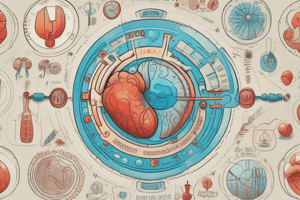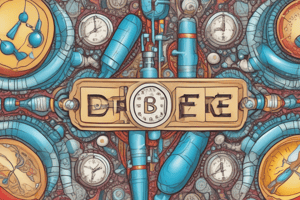Podcast
Questions and Answers
What is the primary cause of hyperglycemia in type 1 diabetes?
What is the primary cause of hyperglycemia in type 1 diabetes?
- Insulin resistance
- Autoimmune destruction of pancreatic beta cells (correct)
- Increased glucose production in liver
- Decreased glucose uptake in muscles
Which of the following is a characteristic of type 2 diabetes?
Which of the following is a characteristic of type 2 diabetes?
- Increased insulin sensitivity in muscles and liver
- Decreased glucose production in liver
- Insulin resistance and impaired insulin secretion (correct)
- Insulin deficiency due to autoimmune destruction of pancreatic beta cells
What is the primary function of insulin in glucose metabolism?
What is the primary function of insulin in glucose metabolism?
- Regulation of insulin resistance in muscles
- Regulation of glucose production in liver
- Regulation of insulin secretion in pancreatic beta cells
- Regulation of glucose uptake in muscles and liver (correct)
What is the consequence of insulin resistance in type 2 diabetes?
What is the consequence of insulin resistance in type 2 diabetes?
What is the primary defect in beta-cell function in type 2 diabetes?
What is the primary defect in beta-cell function in type 2 diabetes?
What is the primary diagnostic criterion for diagnosing diabetes based on hemoglobin A1c?
What is the primary diagnostic criterion for diagnosing diabetes based on hemoglobin A1c?
Which of the following is NOT a common symptom of diabetes?
Which of the following is NOT a common symptom of diabetes?
What is the primary goal of self-monitoring of blood glucose in diabetes management?
What is the primary goal of self-monitoring of blood glucose in diabetes management?
What is the recommended age for universal screening for diabetes?
What is the recommended age for universal screening for diabetes?
Which type of diabetes may require insulin therapy?
Which type of diabetes may require insulin therapy?
Flashcards are hidden until you start studying
Study Notes
Definition and Classification
- Diabetes mellitus is a group of metabolic disorders characterized by high blood sugar levels (hyperglycemia) resulting from defects in insulin secretion, insulin action, or both.
- Classified into two main categories:
- Type 1 Diabetes (T1D): Insulin deficiency due to autoimmune destruction of pancreatic beta cells.
- Type 2 Diabetes (T2D): Insulin resistance and impaired insulin secretion.
Pathophysiology
- Glucose Metabolism: Insulin regulates glucose uptake in cells, especially in muscles and liver.
- Insulin Resistance: Decreased insulin sensitivity in T2D, leading to increased glucose production in liver and decreased glucose uptake in muscles.
- Beta-Cell Dysfunction: Decreased insulin secretion in T2D, leading to hyperglycemia.
Signs and Symptoms
- Common Symptoms:
- Polyuria (frequent urination)
- Polydipsia (excessive thirst)
- Polyphagia (increased hunger)
- Fatigue
- Blurred vision
- Long-term Complications:
- Microvascular: retinopathy, nephropathy, neuropathy
- Macrovascular: cardiovascular disease, peripheral artery disease
Diagnosis and Screening
- Diagnostic Criteria:
- Fasting plasma glucose ≥ 126 mg/dL
- 2-hour plasma glucose ≥ 200 mg/dL during an oral glucose tolerance test
- Hemoglobin A1c (HbA1c) ≥ 6.5%
- Screening Recommendations:
- Universal screening for adults ≥ 45 years old
- Earlier screening for individuals with risk factors (e.g., obesity, family history)
Management and Treatment
- Lifestyle Modifications:
- Healthy diet
- Regular physical activity
- Weight loss (if overweight or obese)
- Pharmacological Therapy:
- Oral medications (e.g., metformin, sulfonylureas)
- Insulin therapy (for T1D and some T2D cases)
- Self-Monitoring of Blood Glucose:
- Regular monitoring of blood glucose levels
- Adjusting diet, physical activity, and medication as needed
Studying That Suits You
Use AI to generate personalized quizzes and flashcards to suit your learning preferences.




